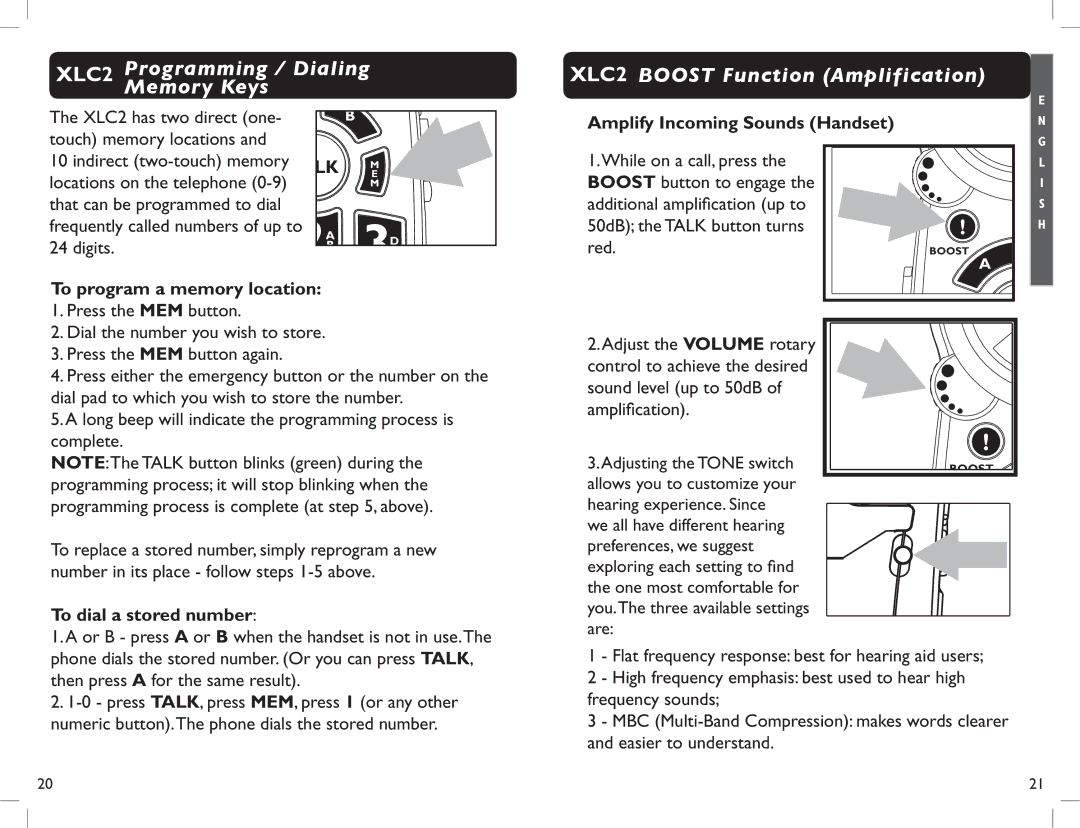Extra Loud Big Button Cordless Speakerphone
XLC2 Table of Contents
XLC2 Important Safety Instructions
Use caution when installing or modifying telephone lines
XLC2 Package Contents
XLC2 Installation
XLC2 Wall Mounting Your XLC2
XLC2 Feature List & Overview Base
XLC2 FeatureHandsetList & Overview
Feature List & Overview
Handset
XLC2 Battery Information
Amplifier settings used. Replace batteries every two years
XLC2 Battery Safety Information
XLC2 Low Battery Indication
Base if optional batteries are installed
Dispose of used batteries according to the instructions
Amplify Incoming Sounds Handset
To program a memory location
To dial a stored number
XLC2 Auto Boost Function
XLC2 Outgoing Speech Amplification OSA
Call
Heard
XLC2 Troubleshooting
Talk button is blinking red twice every 2 seconds
Visual Ringer is blinking red twice every 5 seconds
Ringer does not work
XLC2 Technical Information
XLC2 Regulatory Compliance
Important Information for Customers
For help
This phone
Nearby persons
Could void the user’s authority to operate the equipment
XLC2 Warranty
Clarity Service Center
Plantronics Service Centre
Incidental or Consequential Damages Neither
Proof-of-purchase indicating
’utilisateur
XLC2 Table des matières
XLC2 Consignes de Sécurité Importantes
Orage Ne jamais installer de prises téléphoniques dans des
Afin de réduire les risques de chocs électriques, ne
Couvertes par les instructions d’utilisation. Un réglage
Pour rétablir le fonctionnement normal du téléphone
XLC2 Contenu du paquet
Si non, vérifier toutes les connexions encore
XLC2 Mur montant votre XLC2
XLC2 Liste des fonctionnalités et aperçu Base
’est pas en cours d’utilisation
XLC2 Liste des fonctionnalités et aperçu Combiné
Mode Boost désactivé
Selon les paramètres ci-dessous
Vert lorsque le téléphone est en cours d’utilisation, le
Rouge lorsque la fonction Boost est activée
XLC2 Informations sur les piles
Base facultatif
Base si les piles en option sont installées
XLC2 Indication de pile faible
Jetez les piles usagées selon les instructions
Soyez prudent dans la manipulation de piles afin de ne pas
Pour programmer un emplacement de mémoire
Amplifie les sons entrants combiné
Pour numéroter un numéro enregistré
XLC2 Fonction d’AUGMENTATION
XLC2 Amplification de la voix Sortante OSA
Jusqu’à ce qu’un bip se fasse entendre
Votre voix, appuyez et maintenez enfoncé à nouveau le
XLC2 Dépannage
La sonnerie ne fonctionne pas
Difficulté à émettre ou recevoir des appels
Impossible d’accéder aux systèmes automatisés
Mauvaise qualité audio
Niveau dB amplifié 50dB Dimensions
XLC2 Informations techniques
XLC2 Conformité réglimentaire
Poids
Connecté à votre ligne téléphonique, assurez-vous que
Doit approuver la connexion au préalable
Renseignements sur la du règlement
Qu’il lui est permis de se raccorder aux installations de
Dans la mesure du possible, déplacez le téléviseur, la
De RF DE FCC
Cet équipement pas expressément approuvé par le parti
XLC2 Garantie
Centre de réparation Clarity
Centre de réparation Plantronics 151 Hymus
Fabriquent différents types d’équipement et Clarity ne
Teléfono
XLC2 Índice
XLC2 Instruccionesimportantes de seguridad
No siga utilizando el producto y contacte con Clarity si se
XLC2 Contenido del paquete
XLC2 Instalación
XLC2 Pared que monta su XLC2
XLC2 Lista de funciones y descripción general base
Timbre visual base Se enciende cuando suena el teléfono
Comprado separadamente de su proveedor de Internet
Teléfono no esté en uso
XLC2 Lista de funciones y descripción general auricular
Speakerphone En modo TALK, presione el botón
Para atender el teléfono en modo altavoz, presione el botón
Cuando el altavoz está activo, el botón se ilumina en rojo
Boost
XLC2 Información sobre la batería
XLC2 Indicación de batería baja
Memoria Abra puerta de compartimiento de batería
Auricular
Deseche las baterías usadas según las instrucciones
Para programar una posición de la memoria
Para marcar un número guardado
XLC2 Función Boost amplificación
XLC2 Función Auto Boost
Amplificar los sonidos entrantes auricular
XLC2 Amplificación del volumen de salida OSA
XLC2 Resolución de problemas
Tres segundos hasta que la luz de fondo del teclado
Suelte el botón Flash
Erde, cuando el teléfono esté en uso, fuera del modo
El botón Talk parpadea de color rojo dos veces cada
El Timbre Visual parpadea de color rojo dos veces
XLC2 Información técnica
XLC2 Conformidad con los reglamentos
Mantener el servicio sin interrupciones
Información sobre la Parte 15 de los reglamentos de la FCC
El cliente debe ser consciente de que es posible que el
Especificaciones técnicas de Industry Canada
XLC2 GarantÍa
Hymus Pointe Claire, Quebec H9R 1E9 Tel 800-540-8363 ó Fax
Mano de obra durante un período de un 1 año a partir
Obligación de
119

 !
!